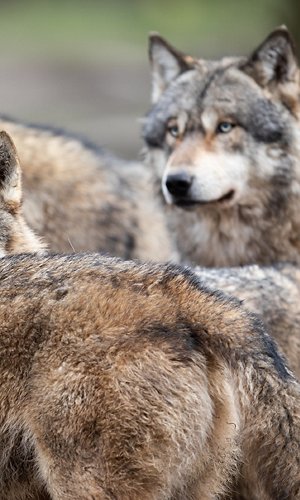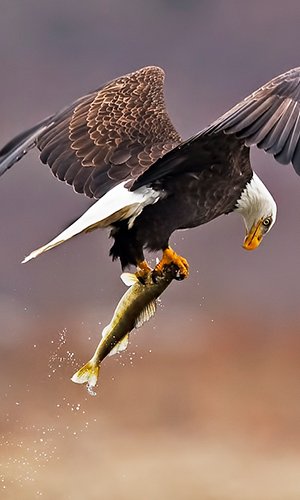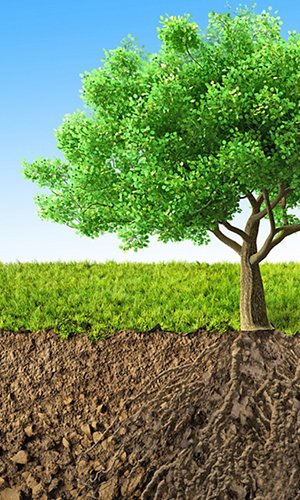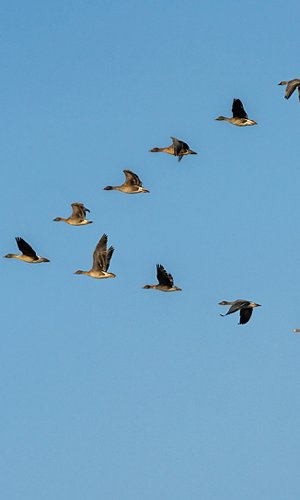When we hear someone talking about animals, we immediately think of the animals we know best and that are evolutively nearer to us, like birds and mammals. Actually, the larger part of the animal kingdom is made up of invertebrates, animals without a skeleton, that account for 95% of the living species. Jellyfish, corals, worms, arachnids, crustaceans, molluscs, echinoderms and, among the most numerous species, insects, are all very different from one another and they populate all the environments on land and in the seas. These are mainly small sized animals, with the exception of the giant squid that is the largest living invertebrate, whose tentacles grow up to twenty meters long. Reptiles exist since millions of years, and their ancestors were amphibian, and lived both on land and in the water. Their size, and their structure varies greatly: tortoises, crocodiles, alligators, lizards and snakes are reptiles. From 230 to 65 million years ago, the Earth was dominated by dinosaurs that became extinct at the end of the period. 150 million years ago, birds evolved from the reptiles and they were characterized by their capacity to fly, that enabled them to spread rapidly to all the environments of the planet. Mammals can survive in almost all the environments and can adapt to various climates: to life in the jungle, in the desert, in the polar regions, in the air, in the oceans, underground, on trees, and they move from one environment to another. In order to live in each environment, mammals have developed different bodies: most of the domestic animals, humans, bats, whales, elephants and beavers, kangaroos, koalas, the duck-billed platypus and bears are mammals!
Voice search
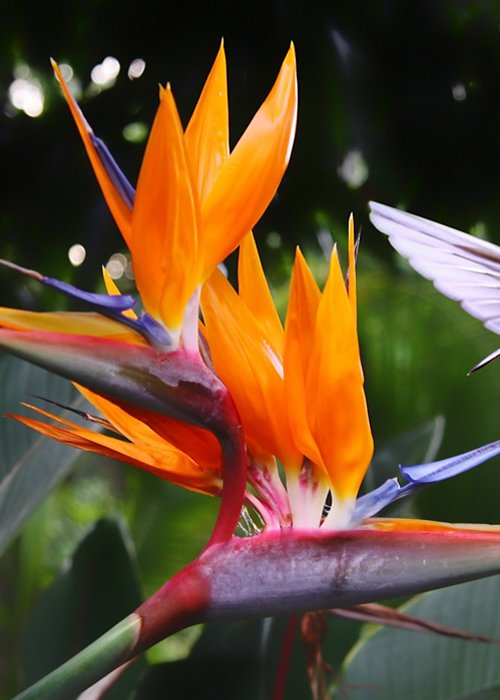
In view of the close relationship between man and nature, since the antiquity people have been trying to know more about the living creatures and to class them. In the IV century b.C., Aristotle, the great Greek philosopher and scientist, began to class the known animals according to their physical features. Obviously, at that time very little was known on the internal anatomy of animals and such classification was therefore mainly based on the observation of their external features and was therefore rather approximate. The modern classification was developed by the Swedish scientist Linnaeus, who in the XVIII century introduced the concept of SPECIES (“group of individuals having the same characteristics and that, by mating, give birth to a fertile offspring, i.e. that can reproduce in its turn”). In addition, Linnaeus gave to each species two Latin names, the first indicating the genus, written with a capital initial, the second one indicating the species, written instead with a small initial, both in italic. Very similar species are grouped into GENERA and likewise similar genera are grouped into the wider set of the FAMILY; families in their turn are grouped into ORDERS, orders into CLASSES, classes into TYPES or Phyla and finally types into KINGDOMS. There are five kingdoms: ANIMAL, VEGETAL, FUNGI, PROTISTA, MONERA.
Related topic
Animals’ reproduction
Most of animals, even the simplest ones, have a sexed reproduction, which allows to increase the genetic variability of individuals and organisms’ diversity. Their internal organs, which are different in males and females, are called gonads and specifically produce gametes (sexed cells: sperms and egg-cells). They are bound to join and form a single cell called zygote or fertilized egg, from which the embryo, that is the new organism, will develop. Some animals, even invertebrates, are hermaphrodites, as they are able to produce both sperms and egg-cells.
How many animals?
The animal kingdom is characterized by the exceptional range of organisms that belong to it. In fact, there are at least 30 million species. You can have an idea of this variety of species by having a look at the different Phyla animals are grouped in. Among the animals that live in water habitats there are: Porifera, that is sponges, Cnidaria like jellyfish, corals, sea anemones, and hydra. In particular, polyps are able to build limestone support structures that form coral reefs.
Arthropoda
The group of Arthopoda are the most numerous animals on Earth: until today more than a million species of insects and other arthropoda have been classified, while the number of living insects today can reach a billion of billions. Arthropoda can be found in all habitats, and it was calculated that in a mild region there can be 20 million arthropoda distributed in the biosphere.
Animals with spine
The numerous invertebrates’ phyla are characterized by a wide range of shapes and way of living. All the vertebrates (Vertebrata), instead, have a similar body. Despite their limited differences and the modifications in time, the vertebrates have conquered on just emerged lands, but also the sky. Vertebrates include some of the biggest organisms that have ever lived on Earth and our species also belongs to them.
Natural selection and evolution
The Earth has a long history and all organisms, man included, originated during history and came after other forms of life. As a consequence, all species derive from other species, and all living beings have a common ancestor in the past. This was all possible because in time a series of changes occurred having an influence on species: this is evolution. Lamarck and Darwin. Jean-Baptiste Lamarck, a French scientist (1744-1829) thought that the environment is the cause of evolution as it forces animals to use some parts of their body instead of others.
Animals’ behaviour
All organisms provide themselves with food and water, often they manage to avoid being eaten by other organisms, they reproduce themselves (they follow courtship and mating rituals) and finally they take care of their offspring. All these activities are very important for animals’ survival and for species success. Behaviour characteristics are subject to evolution: normally the behaviour varies among single individuals, and behaviours are more advantageous than others. Some variations are determined by genes, and the most successful ones will be predominant.
The distribution of animals
Scientists are convinced that life came from the sea and from there the living organisms conquered, through the necessary evolutionary stages, both the Earth and the internal freshwaters. These steps, moving from the sea to the other environments, occurred in very ancient times, when the living forms were poorly developed and poorly specialised. Later on, the living beings, even though spreading all around, found impassable boundaries that confined them to certain regions.
Fauna in the marine environment
Temperatures at sea are less variable than those on land. The daily and seasonal temperature ranges (differences between the minimum and maximum temperatures reached) are actually shorter there. Salinity, even if very different in different seas, does not normally change too much in one sea. This is why marine organisms, especially those of deeper and offshore waters, did not have to adapt to sudden changes in temperature and salinity, and generally do not tolerate dramatic changes in these two factors.
Fauna in the brackish environment
The areas where river waters flow into the sea are the environment of passage from freshwater to salty water, an environment that, due to sudden daily and seasonal changes in salinity and temperature, can only be inhabited by organisms that are specialised enough to tolerate such peculiar conditions. Because of such a difficult environment, the fauna and flora of brackish waters include quite few species. These few species are however plentiful because of the huge amount of nutrients coming from the rivers.
Hypogean fauna
Caves and tunnels are inhabited by very specialised organisms that, over the centuries, have developed characters that make them particularly suitable for this environment. Most of these animals are invertebrate: anellida, molluscs, insects, crustaceans and arachnida, sometimes also amphibians, reptiles and some species of blind fish. These creatures have no eyes or breathing apparatuses. They breathe straight through the pores that compose the tissue that coats their body.
In the freshwater environment
Freshwaters offer an infinite range of chemical and physical conditions (temperature, depth, pH, etc.). In addition, the biocenoses that live in stagnant waters (swamps, ponds, lakes) are completely different from those of running waters (rivers, torrents). Stagnant waters have, like the sea, a benthos, a plankton and a nekton, but with fewer species. Running waters, due to changes in temperature and water movement, do not have a plankton.
In the terrestrial environment
The environment with the most daily and seasonal changes in the factors that affect animal life is the terrestrial one. These factors depend, among other things, on latitude (from the poles to the Equator) and altitude (from the sea level to mountaintops). Temperature is therefore an important limiting factor for life on Earth. The other limiting factor for terrestrial organisms is the availability of atmospheric water, i.e. humidity in the air and soil due to rains.
Short history on life on Earth
Life on Earth must have started approximately 4 billion years ago and the oldest fossil remains are those of organisms that lived 1 billion years ago: clearly, then, many years of the history of life on Earth are shrouded in the dark of the past and we only know the most recent part of this history. This part, whose remains have been preserved and accidentally found in the geological strata, testifies of organisms that were already very complicated and divisible into Phyla.
Read more...
As early as 20,000 years ago, some Primitive men portrayed on rocks, in caves and in the open air the main events of hunting, mostly by drawing animals (caves of Altamira, Pesche-Merle, etc.). Many of these drawings have now become important documents on the fauna that lived on Earth at some historical times and therefore on the climate and flora as well. All peoples in all continents have produced animal figures, either painted or sculpted, giving them a fantastic or divine dimension. The first important civilisations to have settled along rivers (Nile, Tigris, Euphrates) have distinguished themselves for their strong culture based on deities with animal traits. For the Egyptians, Bastet (the Goddess of joy and sunshine and the protector of the pharaoh) was portrayed as a woman with the head of a cat or as a feline, Anubis (protector of mummification and lord of necropolises) was portrayed with the body of a man and the head of a jackal, he accompanied the dead in their journey to the afterlife and headed the tribunal of the afterlife. Later on, animals have kept going hand in hand with man along the centuries, becoming part of folk cultures in the most bizarre ways. The protagonists of legends, fairy tales and myths are often drakes, talking animals or naughty monsters that have always been talking to man in the simplest and most straightforward way through funny, frightening or educational stories. Some stories derive from well-founded fears, such as that of the wolf, that was really a serious danger, especially in the Middle Ages, when Europe was still mostly covered in forests and in the winter packs of hungry wolves moved closer to villages or even got inside towns. Man feared these animals, not only because of their potentially deadly attacks, but also because of rabies, a disease that was transmitted by their bites and that could not be treated at that time. This historical background is also the source of the werewolf, a man who turns into a wolf during full moon nights. In fact lycanthropy refers to a rare genetic disease, porphyria, which causes hypersensitivity to sunrays, the growth of down on the face and limbs, and finally a red-brown colour of the teeth.
Related topic
Use or exploitation?
For human beings, fauna has always been an important vital resource. Hunting and fishing were the only means that primitive men had at their disposal to eat and clothe themselves. Then, when men left their nomadic lives to settle permanently in a given area, they began to tame animals. Cattle breeding increased the availability of food, such as meat, milk, eggs, honey; in addition, animals also supplied such raw materials as wool and hides. It should not be forgotten, then, that before the internal combustion engine was discovered the most important source of energy and power were just animals.
Animals out in the space
Scientific research was also greatly improved by the use of animals in astronautics. The very first living beings having been launched into space were mice and midges (fruit flies). These insects were chosen for they reproduce very quickly, and this allowed scientists to see very quickly if the cosmic rays could affect the hereditary characters. Laika, a Russian dog, was the first animal to have been sent into space, in particular into orbit around the Earth, in 1957.
Animals as a resource
For humans, animals are a productive resource. First of all, they supply a wide variety of foods that man needs to survive: milk, cheese, eggs, butter, salami and cold meat, etc. Some animal species, such as corals and oysters, are used by man to produce jewels and handicrafts. The hide of some animals is used instead to produce clothes. In many places across the world, animals are still one of the main means of transport.
Read more...
An animal species is seriously threatened with extinction when its population is broken up. Extinction is a natural process that may be caused by natural selection, shortage of food or natural calamities. It has been calculated that 9 species out of 10 of those that have appeared on Earth over the centuries have disappeared. Man’s action on nature has also caused entire animal species to disappear over the years. Hunting, deforestation, pollution, the conversion of uncultivated areas into pastures, the illicit trade of wild animals as well as climatic changes have made life difficult for many animals. The areas that have been hit hardest by the rise in the Earth’s temperature are the Arctic and the oceans. In these places, animals suffer because they have lost their habitat and find it hard to find food to eat. This results in a decrease of births and therefore in the slow disappearance of some species. In the oceans, the reduction of plankton caused many types of fish to migrate and many invertebrate organisms to disappear.
Related topic
How animals can be safeguarded
Nevertheless, over the last few years, man has realised that the loss of some animal species can cause extremely serious damages to the natural course of the food chain, so he tried to help the species most at risk. Many animals, such as, for instance, the chamois and the ibex in Italy, have been brought back to their habitat through a “re-colonisation” operation. For instance, green areas have been extended to protect butterflies. Disappearing animals cannot be hunted or traded.
Biodiversity
The word “biodiversity” was coined in 1988 by Edward O. Wilson, entomologist, and has become common parlance since the 1992 Earth Summit. Biodiversity means the wealth composed of the whole of the genetic information of the living organisms that live in different climatic regions and habitats. Biodiversity originates from the evolutionary process that generated, through natural selection and over the centuries, all the living animal and vegetal species.
How to breed animals
Have you ever wondered how is produced meat you can find well-packaged and neatly filed on shelves at the supermarket? If we retrace the production process, we can discover lots of interesting information on how animals are raised and on the environmental damages resulting from the production of meat, eggs, milk and cheese that we eat every day. In the last decades, a method of breeding which is very far from traditional techniques employed in the past by mankind has got a foothold at a global scale.
Feeding animals
Feeding animals to feed men is an expensive way to produce food. In the world about ¼ of arable lands are employed to produce fodder, soy and cereals and ¼ of these cereals are employed in industrial breeding farms to feed livestock: it’s an expensive energy cost which adds to the economic cost, all the more so since the same lands could be used to produce food that the world’s undernourished population needs. It’s been estimated, in fact, that if all cereals produced every year were shared among the world population, each person would receive much more food than is necessary for survival…
Producing food
An intensive system of production capable of producing a lot of meat in small time has thus got hold to face growing consumers’ demand of meat. Farmers turn a raw material as cereals, available in great amounts at a low price, in meat which we eat. It’s an absolutely inefficient system as it uses much to produce little, in fact, about 7 k of cereals and about 15 thousand litres of water are required to produce 1 k of beef meat!
Man and breeding
Today in the world almost two billion people depend on livestock to satisfy their basic daily needs. The connection between man and breeding is longstanding and has always represented a balanced relationship between man, environment and culture: in the past, in fact, cattle, apart from being employed for meat production, played and still plays a series of fundamental functions. Cattle, in fact, satisfies 30% of man’s needs in terms of its nutrition –production of meat, milk and derivatives – as well as support to agricultural production as workforce.
Ancient balances
The relation between production and consumption of products of animal origin has changed over time. Historically, transport and communication were limited in comparison to the current globalization context and commercialization of fresh products, which thus perish quickly as meat, milk, and eggs was very difficult. For this reason, the demand for this type of food was satisfied locally and cattle breeding, above all, depended on local availability of resources as fodder, pastures and water.
Environment and breeding
Cattle breeding products –eggs, meat, milk and derivatives –supply a third of global human protein intake. As consumption of this type of food isn’t distributed evenly in the countries of the world, at the same time, it causes obesity in western countries (where consumption of this type of food is excessive) and is a potential undernourishment remedy in developing countries (DCs). But the cattle breeding is also one of the main accountable sectors for the many environmental changes registered in the last decades on a local and global scale.
The transformation of the zootechnical sector
Growing demand of animal source foods has determined the need to have highly efficient breeding systems that are thus capable of producing much in little time and space. A tendency is in fact underway leading to intensive breeding and industrial cattle production although extensive pastures still cover wide areas of the planet. In this process, insufficient availability of lands has played a crucial role and has generated the need of developing zootechnical systems requiring less areas in comparison to animal production.
Breeding and soil
The zootechnical sector is the main sector accountable for the use of soil and its progressive drying. Animal production occupies 30% of all lands existing on the planet plus pastures which cover 26% of lands. In particular, 33% of arable lands are destined for crops that produce food for breeding farms. Intensive breeding, for example, destroys soil because cereal cultivation to produce fodder requires many arable lands. Agriculture can contribute to desertification both, directly, through harmful agricultural practices as intensive farming and unrestrained water use and, indirectly, when land is deforested to create new farming areas to feed cattle.
Climate and atmosphere
The greenhouse effect, the phenomenon that entails the overheating of the planet, is caused by the presence in the atmosphere of different substances, which are normally existing in nature in low concentrations but that are now produced in high quantities by human activities, especially in the last decades (combustion of fuels to move from one place to another, to make machinery work, fuels to produce electric energy, etc.). Among these substances, some have a stronger impact as methane (CH4) and nitrous oxide (N2O), others, as carbon dioxide (CO2), affect less the greenhouse effect but are produced in great amount by humans.
Water employed for breeding
By 2025 more than 60% of the world population will live in water-stressed conditions. The zootechnical sector substantially contributes to water consumption and its pollution both directly and indirectly: 8% of world hydric consumption concerns the zootechnical sector that employs water mainly to irrigate farmed fields to produce fodder. Just think that 15 thousand litres of water are required to produce 1 k of beef! To produce 1 k of chicken we need 3,500 litres of water whereas the production of cereals requires less water, that is 3,400 litres for rice, 2 thousand for soy, 1,400 for wheat, 900 for corn and 500 for potatoes.
Breeding and biodiversity
We live in a time of great threat to biodiversity, today in fact the loss of animal and plant species is hundreds of times faster than in the past centuries. Zootechnical activities causes substantial effects on aspects related to biodiversity and reduction of varieties of life forms as deforestation, soil impoverishment, pollution and climate change that, for that matter, breeding actively contributes, are causes determining a great loss of biodiversity. The impact is also due to the high number of heads of cattle currently raised that represent 20% of the biomass of all animals existing in the world and that occupy 30% of lands that were once inhabited by wild animals.
Diseases and breeding
The production of animal food is undergoing a great transformation on a global scale that could entail an increase of the risk of transmitting diseases from animals to humans (zoonosis). Excessive concentration of heads of cattle in breeding factories should be avoided to limit this risk as well as improving the system for monitoring diseases and preserving public health. Cattle production and density have substantially increased, often in proximity to urban centres, especially with regards to industrial pigs and poultry breeding factories…
Many types of breeding
Factors as climate (for example tropical or desert), as the structure of lands (for example flat or mountainous), as the availability of resources (for example water) but also other elements as cultures and local economies make breeding systems acquire different forms in terms of its dimension as well as type of techniques used. In the world there are many types of breeding that are very different from one another; let’s just think about how different nomad horse and yak breeding in Mongolia from breeding of bovines in our farmsteads is!
How do breeding farms work?
Animals can be raised in different ways as intensive breeding farms, industrial breeding farms and pasture breeding farms also called extensive. Let’s have a closer look.
Extensive breeding farm or “pasture”. In this system animals can pasture freely and munch grass. If temperatures are very low animals have the chance to shelter in stables where they are fed by humans. It’s an independent system that possesses lands for pasture and to produce nourishment for animals, either hay or cereals...
Read more...
Current meat consumption has grown a lot in comparison to the past: FAO has estimated that they have been raising globally by almost 400% in comparison to 1961. Today in industrialized countries meat per head consumption is around 80k. As for our regards, in industrialized countries, consumption will increase to reach overally 90 k per head per year. As we have seen, meat, eggs and cheese production can have a strong impact on the environment and not always can preserve the well-being of animals, especially if these are raised with an intensive and industrial system. To understand how we “consumers” can choose the less harmful products for the environment and for our health we should think about the different actors involved in the animal production chain and identify which tools are available for them to produce more sustainably. Consumers, finally, can lower their meat consumption and make sustainable buying choices.
Related topic
Integrating our diet
It’s generally better to lower our meat consumption, especially red meat: a kilogram of beef meat, in fact, is responsible for the emission in the atmosphere of the same amount of CO2 emitted by an average European car every 250 kilometres and burns sufficient energy to keep a 100 watt light bulb lighted for 20 days!! Moreover, according to some experts an excessive consumption of meat would have negative effects on our health: it would increase, in fact, occurrence of cancer, vascular diseases, diabetes and obesity.
Eating local products
Favouring local products, or the so-called “zero-kilometre products” is a good solution to avoid long trips of animals and food coming from the other side of the world. This solution, at the same time, allows to emit in the atmosphere, indirectly, less amounts of greenhouse gases. You can also address farmsteads of your area to buy meat, cold cuts, cheese and other dairy products. You can also collect fresh milk from raw milk distributors spread in farmsteads and also in our cities and remember to bring your own empty bottle to fill it!
Eating biological products
The choice of biological products today is still influenced by their price that is higher in comparison to traditional foods. Buying biological products directly from producers in the so-called “farmers markets” or directly in farms is a solution to avoid the overpricing problem. Buying biological food means choosing products that have been produced without pesticides, herbicides and chemical fertilizers reducing their impact on the environment and avoiding soil and groundwater pollution by these substances.


